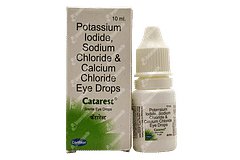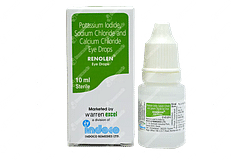Calcium Chloride + Phenylmercuric Nitrate + Potassium Iodide + Sodium Chloride
Uses of Calcium Chloride + Phenylmercuric Nitrate + Potassium Iodide + Sodium Chloride
Calcium Chloride + Phenylmercuric Nitrate + Potassium Iodide + Sodium Chloride is primarily used in ophthalmic preparations for the prevention and management of corneal opacities and cataracts, certain eye infections, and reduction of intraocular pressure in glaucoma. This combination belongs to a group of ophthalmic medicines.
Additionally, the individual components of the combination have their specific roles. For example, calcium chloride maintains corneal transparency and prevents opacity formation, phenylmercuric nitrate acts as a preservative and antimicrobial agent, potassium iodide helps in the prevention and treatment of corneal ulcers and opacities, and sodium chloride provides isotonicity to the ophthalmic solution.
Side effects of Calcium Chloride + Phenylmercuric Nitrate + Potassium Iodide + Sodium Chloride
Temporary stinging or burning sensation in the eye
Mild eye irritation or redness
Blurred vision immediately after application
Allergic reactions, such as itching or swelling
Severe eye pain or increased irritation
How Calcium Chloride + Phenylmercuric Nitrate + Potassium Iodide + Sodium Chloride works
Calcium Chloride maintains the integrity of the corneal epithelium, it prevents the formation of opacities by regulating the hydration and transparency of the cornea.
Phenylmercuric Nitrate has antimicrobial properties. It inhibits the growth of bacteria and fungi, thus helping to manage eye infections.
Potassium Iodide acts as an anti-inflammatory and antioxidant agent. It aids in the healing of corneal ulcers and prevents the formation of opacities.
Sodium Chloride ensures that the ophthalmic solution remains isotonic with the eye's natural fluids, preventing discomfort and irritation when administered.
Together, these components work synergistically to manage various ocular conditions effectively.
Certified content
Written By

Doctor of Medicine
Reviewed By

BMS, FMC, MD Resident
Expert Advice
Dosage Forms Available
Calcium Chloride + Phenylmercuric Nitrate + Potassium Iodide + Sodium Chloride is available for use via the ocular route in the form of eye drops, eye ointments, and eye irrigation solutions.
Age and Dose Restrictions
This medicine is meant for adults and children above 2 years of age.
Contraindications
This medicine is contraindicated in patients with known hypersensitivity to any of the ingredients, acute anterior uveitis, or other inflammatory eye conditions, and severe dry eye syndrome.
Other Medications to Avoid
This combination may interact with other ophthalmic medications (such as antibiotics or corticosteroids) and systemic medications that have ocular side effects (such as antihistamines or diuretics).
Overdose and Missed Dose
In case you happen to put a few extra drops of this medicine in your eye, do not panic. Rinse your eyes with clean water at room temperature. If any symptoms persist or worsen, inform your doctor.
If you forget to apply this medicine, apply it as soon as you remember. But avoid repeating the dose.
Management of Side Effects
Most side effects are temporary and generally harmless and resolve when discontinuing this medicine. However, if you experience any severe side effects or worsening of any of the symptoms, please consult your doctor.
For temporary stinging or burning sensation in the eye after applying the medication, wait for a while till it subsides.
For mild eye irritation or redness, you can use a cool compress.
Use in Driving and Operating Machinery
This medication may affect your ability to drive or operate heavy machinery. Avoid driving if you feel blurred vision after applying this medication.
Use in Pregnancy and Lactation
The safety of this combination during pregnancy and lactation has not been established. Patients should consult their doctor before using it in these situations.
Caution in Other Conditions
Patients with certain eye conditions should exercise caution when using this medicine. Always inform your eye care professional about any pre-existing eye conditions or allergies before using this combination.
Special Dietary and Lifestyle Recommendations
Maintain good eye hygiene to prevent any infections.
Wear sunglasses when going out in the sun to protect your eyes from harmful UV rays.
Take breaks when using electronic devices for extended periods to prevent eye strain.
Include foods rich in Vitamin A and other antioxidants in your diet to keep your eyes healthy.
Frequently asked questions
Is Calcium Chloride + Phenylmercuric Nitrate + Potassium Iodide + Sodium Chloride a steroid?
No, Calcium Chloride + Phenylmercuric Nitrate + Potassium Iodide + Sodium Chloride is not a steroid. These are chemical compounds used in ophthalmic preparations for different medical uses.
Can I use Calcium Chloride + Phenylmercuric Nitrate + Potassium Iodide + Sodium Chloride daily?
The duration and frequency of use of this medicine should be as per doctor's instructions. It should never be self-administered without a prescription.
How much time does Calcium Chloride + Phenylmercuric Nitrate + Potassium Iodide + Sodium Chloride take to work?
The onset of action may vary depending on the specific formulation and the condition being treated. Some patients may experience relief within a few minutes, while others may require several days of consistent use.
What is the best time to administer Calcium Chloride + Phenylmercuric Nitrate + Potassium Iodide + Sodium Chloride?
The best time to use the medication would be as per your doctor's instructions. This is because the timing can depend on factors such as the specific condition being managed, your overall health status, and the other medications you may be taking.
What happens if I accidentally ingest Calcium Chloride + Phenylmercuric Nitrate + Potassium Iodide + Sodium Chloride?
This combination is meant for topical use only and should not be ingested. If accidentally swallowed, you should seek immediate medical attention.
Can Calcium Chloride + Phenylmercuric Nitrate + Potassium Iodide + Sodium Chloride cause allergy?
Yes, although rare, allergic reactions may occur in some individuals. Symptoms may include itching, swelling, or difficulty breathing. If you experience any signs of an allergic reaction, you should seek immediate medical attention.
Is Calcium Chloride + Phenylmercuric Nitrate + Potassium Iodide + Sodium Chloride a prescription medicine or can it be bought over the counter?
Calcium Chloride + Phenylmercuric Nitrate + Potassium Iodide + Sodium Chloride is usually a prescription medicine and is not typically available over the counter.
Calcium Chloride + Phenylmercuric Nitrate + Potassium Iodide + Sodium Chloride in other salts





Subscribe
Claim your complimentary health and fitness tips subscription and stay updated on our newest promotions.
Download Truemeds
Manage your health with ease Download Truemeds today!Get easy access to medicine refills, health information, and more. With our app, you'll never have to wait in line again. Download now and start taking control of your health.

Contact Us
Our customer representative team is available 7 days a week from 9 am - 9 pm.
v3.4.14
Our Payment Partners








